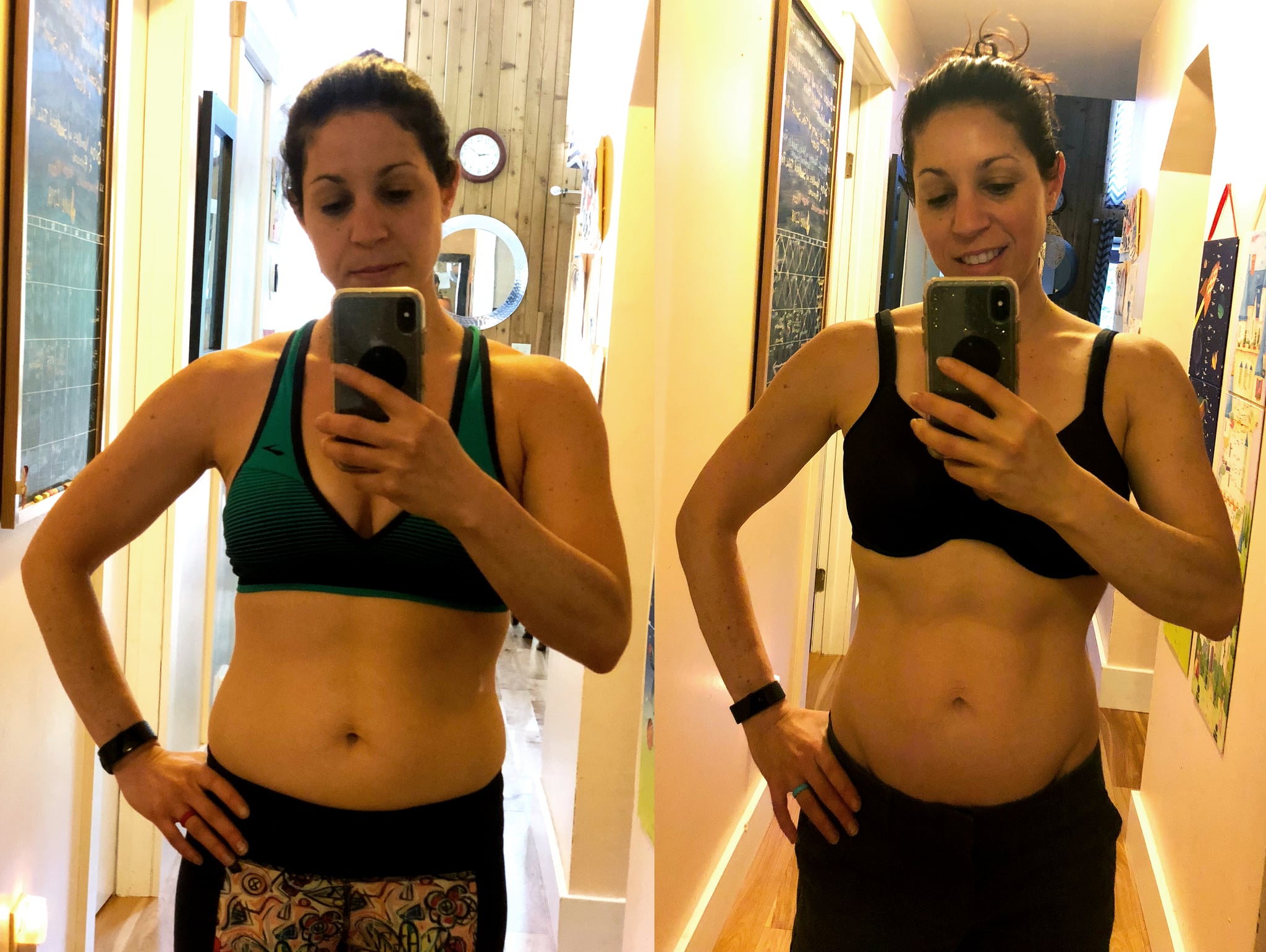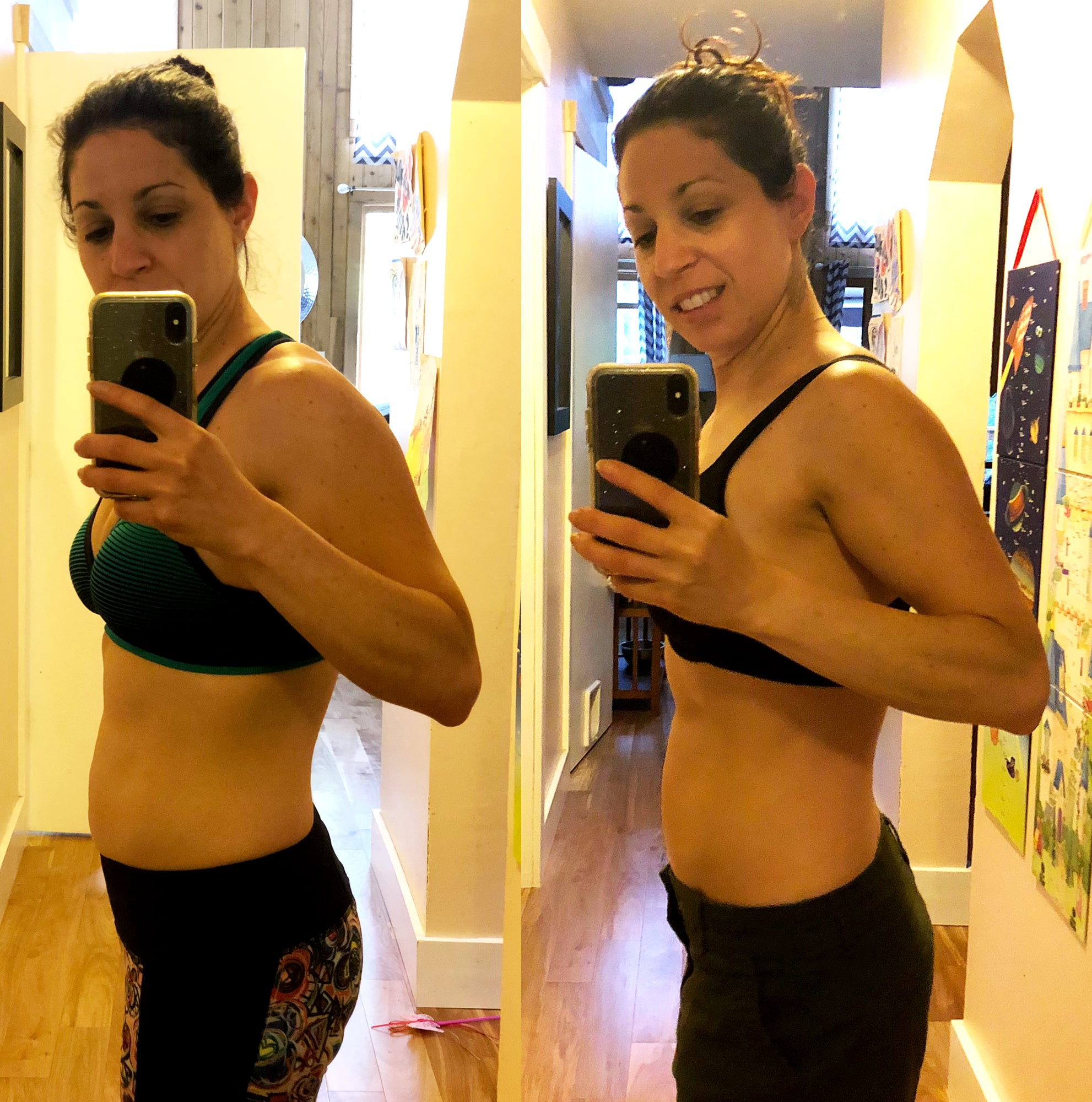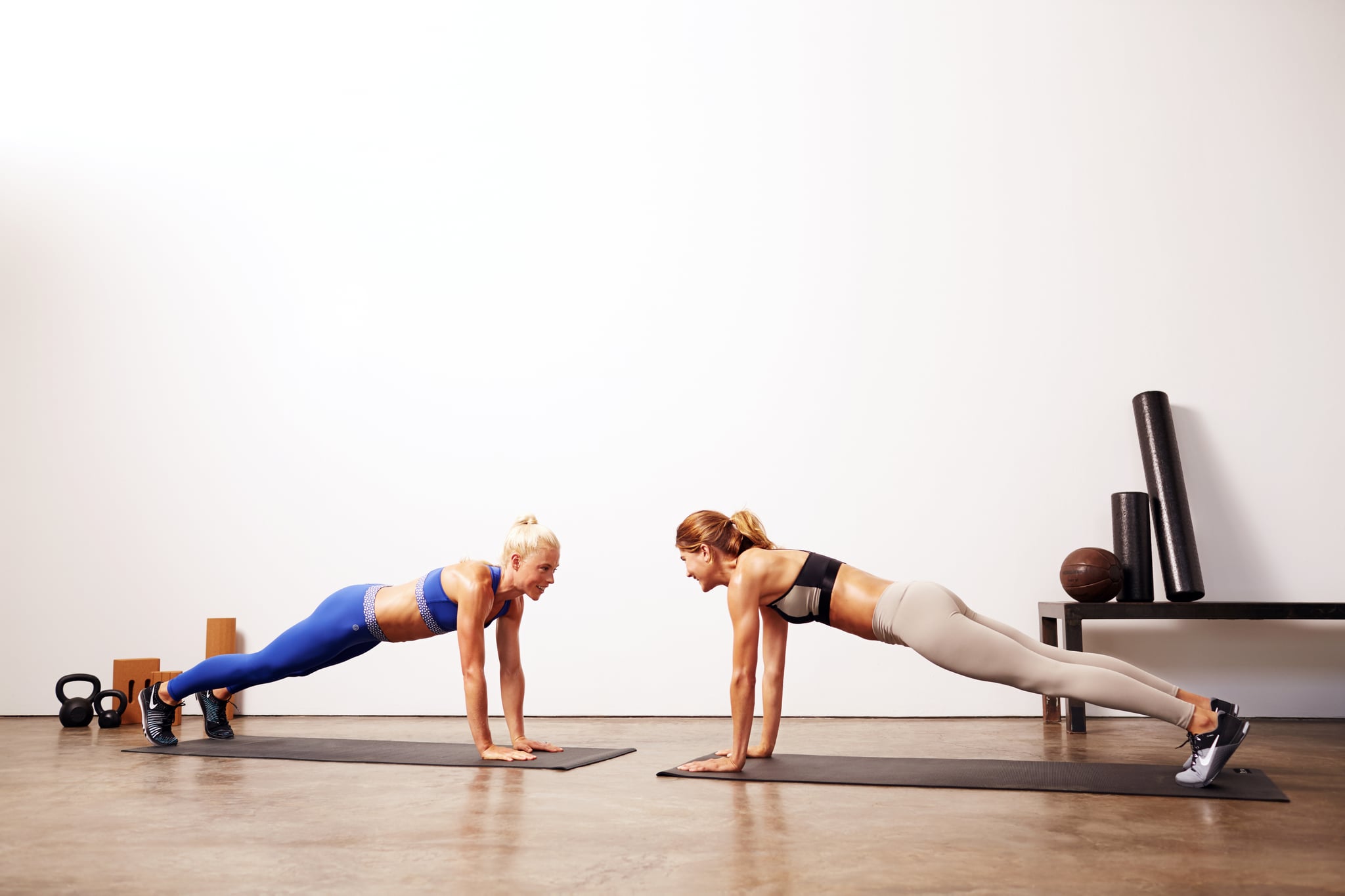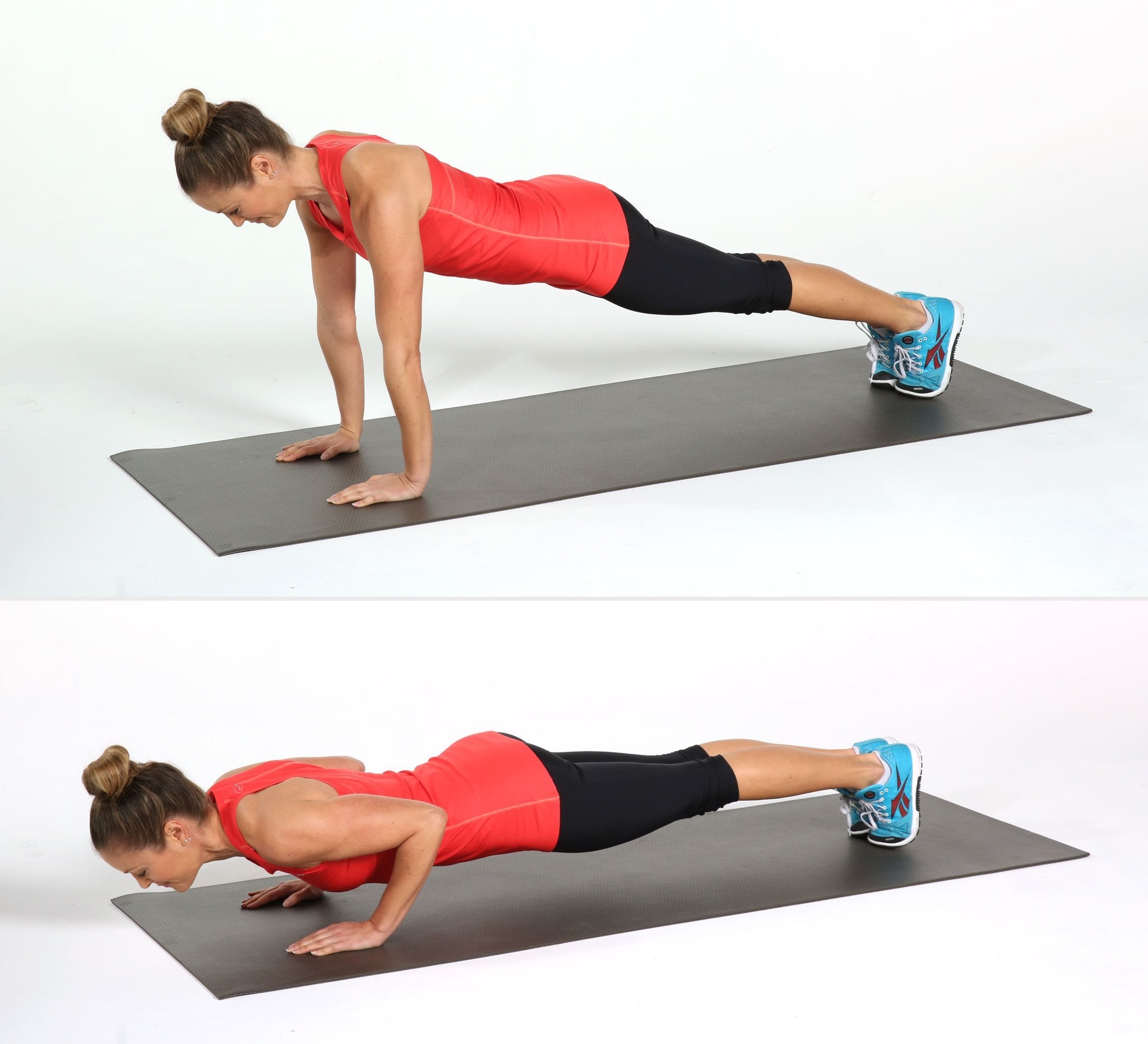Wednesday, June 27, 2018
After Years of Struggling, Here's How I Finally Learned to Do Push-Ups
Let me tell you about my relationship with push-ups — as in, it didn't really exist. After years and years (and years!) of working out, being able to do a set of perfect push-ups never seemed to happen for me. I can plank for a decent amount of time, deadlift a respectable barbell weight, and have run my fair share of races . . . but push-ups? Nope. And as a fitness editor, this has always felt embarrassing. This month I decided to get serious, conquer the elusive push-up, and invested in personal training.
A negative push-up focuses solely on the downward (aka, eccentric) movement of the push-up. An easy way to envision the exercise is to think of it like doing one-half of a full push-up; by putting all the load on the eccentric movement, "you focus on elongating the muscle," said Austin.
I Did Alternate Day Fasting and This Is What My Belly Looked Like After 3 Weeks
June 26, 2018I sprang into Spring excited to start running more and ended up hurting my knee. I took a month-long break from running and CrossFit classes to heal and also did a bunch of traveling, so I was eating like crap. All that added up to some weight gain, and my usual 16:8 intermittent fasting (IF) schedule wasn't helping me drop those pounds. I decided to try alternate day fasting (ADF).
 What Is Alternate Day Fasting?
What Is Alternate Day Fasting?
Alternate day fasting (ADF), a form of intermittent fasting, involves fasting one day, eating the next, and repeating. If you need to, you are allowed to eat on fasting days, the recommended amount being 25 percent of your total calories. For example, if you've calculated that 1,800 calories a day is the amount you need to eat in order to lose weight, on a fasting day, you'd eat no more than 450 calories. On nonfasting days, you'd eat 1,800 calories.
Why I Tried ADF
First and foremost, I spoke with my doctor, the registered dietitian I was seeing, and even my gynecologist about how I wanted to try ADF to make sure this was safe for me. They knew I had been doing 16:8 IF for over a year, and I explained that now that I was in my 40s, I was having a hard time losing belly fat and was concerned because it's the unsafe kind of visceral fat that can lead to cancer (which is in my family).
I also spoke to them about my issue with overeating, my sugar cravings, and belly bloat and how fasting longer in the past has helped with that. After having blood tests, they all said ADF was safe as long as I felt good and energetic and had no negative side effects. We decided that once I lost the belly fat, I'd go back to 16:8 — I mean, this didn't sound fun at all, so it wouldn't be something I'd want to continue.
What I Did
To complement my workout schedule and family life, I fasted Mondays, Wednesdays, and Fridays so I could have the weekends to enjoy eating with my family. With my previous experience doing 5:2, where I ate 500 calories a day on those two fasting days, I found that eating such a small amount actually made me more hungry. So for ADF, I didn't consume any calories during the 24-hour fasting window, which was from 6 p.m until 6 p.m. the following day. I only drank water, sparkling mineral water, black coffee, and tea. My week of eating looked like this:
Monday: ate 6 p.m. to 8 p.m.
Tuesday: ate 10 a.m. to 6 p.m.Wednesday: ate 6 p.m. to 8 p.m.Thursday: ate 10 a.m. to 6 p.m.
Friday: ate 6 p.m. to 9 p.m.
Saturday: no restrictions
Sunday: ate 10 a.m. to 6 p.m.
As you can see, I still did 16:8 intermittent fasting on Tuesdays, Thursdays, and Sundays. I'm so used to not eating breakfast, and since I wasn't hungry on those mornings, I didn't eat. I ate very well on those nonfasting days, consuming probably 2,000 to 2,500 calories (I didn't track it), and just made sure to stop eating around 6 p.m. so I could eat dinner at 6 p.m. the next day.
On my fasting days (Mondays, Wednesdays, and Fridays), I ate a huge dinner at 6 p.m., then at around 7:45 p.m., I'd eat a mini meal of nuts and fruit, a whole avocado with sunflower seeds, or homemade fruit and nut bars smeared with nut butter (gotta have those healthy fats!). On those fasting days, I didn't really keep track but definitely ate around 1,400 calories. On Saturdays, I ate what and when I wanted.
 What Surprised Me?
What Surprised Me?
I wasn't super hungry on those fasting days. I thought I'd be famished and hangry, but I wasn't. I guess I was used to not eating breakfast, so on those fasting days, the only difference was that I was skipping lunch and afternoon snack. I was surprised that my hunger level always felt the same; it didn't get more intense as the day progressed. By the second and third weeks, hunger wasn't really an issue.
The Pros
I felt energized and clear-headed, I had absolutely no bloating, I slept well, and I had less cravings for sugar and other crappy food. Since I was spending less time prepping, cooking, and cleaning up after meals, I had more time to do other things — I was more productive. It sounds insane, but I found I was actually looking forward to my fasting days because I felt so good, especially on Mondays, as a way to reset after a deliciously indulgent weekend.
Eating big meals, not counting calories or carbs (or cookies!), and having no restrictions on the foods I ate during my feeding windows was so freeing. I felt satisfied physically and emotionally, and even though I had specific times to eat and fast, it didn't feel strict or hard to follow. Fasting for 24 hours also let me know what true hunger felt like, which helped prevent mindless eating on my nonfasting days.
 The Cons
The Cons
Not eating for 24 hours sucked at first (obviously!). I was definitely hungry by the time dinner rolled around, and I was so excited that I could sit down to eat that I ended up overeating. It only took a few times to feel full and bloated, so by the second week, this wasn't an issue.
Was I Able to Work Out?
I continued to do morning CrossFit classes or runs, and I felt great since I was fueled from dinner the night before. I was used to not eating before my workouts, so nothing felt different here. I still had tons of energy and endurance. The only times I felt crappy were if I didn't eat enough protein and healthy fats the night before, but that had nothing to do with ADF.
Did I Lose Weight?
I not only saw the scale numbers drop an average of one pound a week, but I could see from the before and after photos that I definitely lost belly fat and my face looked thinner. I saw more muscle definition in my arms and upper back and just felt leaner and less puffy.
Now What?
ADF wasn't so bad! I liked how my schedule was consistent, I could still work out, I could eat every day, and I was still able to lose weight. I plan to do this for one more week, then I'll go back to 16:8 and hopefully maintain what I've accomplished.
Final Thoughts
If you're considering trying intermittent fasting, consult with your doctor and get the green light first, because IF isn't safe for everyone. If you do get the OK, start off with an easier form of IF, like fasting for 12 hours a day (7 p.m. until 7 a.m. the next morning) to allow your body to adjust. ADF is a very advanced form of IF and may not be suitable for everyone. I have been doing intermittent fasting for well over a year and built up to alternate day fasting. It's important to listen to your body and do what's right, safe, and healthy for you.
via : PopSugarx
I Did Alternate Day Fasting and This Is What My Belly Looked Like After 3 Weeks
I sprang into Spring excited to start running more and ended up hurting my knee. I took a month-long break from running and CrossFit classes to heal and also did a bunch of traveling, so I was eating like crap. All that added up to some weight gain, and my usual 16:8 intermittent fasting (IF) schedule wasn't helping me drop those pounds. I decided to try alternate day fasting (ADF).
What Is Alternate Day Fasting?
Alternate day fasting (ADF), a form of intermittent fasting, involves fasting one day, eating the next, and repeating. If you need to, you are allowed to eat on fasting days, the recommended amount being 25 percent of your total calories. For example, if you've calculated that 1,800 calories a day is the amount you need to eat in order to lose weight, on a fasting day, you'd eat no more than 450 calories. On nonfasting days, you'd eat 1,800 calories.
Why I Tried ADF
First and foremost, I spoke with my doctor, the registered dietitian I was seeing, and even my gynecologist about how I wanted to try ADF to make sure this was safe for me. They knew I had been doing 16:8 IF for over a year, and I explained that now that I was in my 40s, I was having a hard time losing belly fat and was concerned because it's the unsafe kind of visceral fat that can lead to cancer (which is in my family).
I also spoke to them about my issue with overeating, my sugar cravings, and belly bloat and how fasting longer in the past has helped with that. After having blood tests, they all said ADF was safe as long as I felt good and energetic and had no negative side effects. We decided that once I lost the belly fat, I'd go back to 16:8 — I mean, this didn't sound fun at all, so it wouldn't be something I'd want to continue.
What I Did
To complement my workout schedule and family life, I fasted Mondays, Wednesdays, and Fridays so I could have the weekends to enjoy eating with my family. With my previous experience doing 5:2, where I ate 500 calories a day on those two fasting days, I found that eating such a small amount actually made me more hungry. So for ADF, I didn't consume any calories during the 24-hour fasting window, which was from 6 p.m until 6 p.m. the following day. I only drank water, sparkling mineral water, black coffee, and tea. My week of eating looked like this:
Monday: ate 6 p.m. to 8 p.m.
Tuesday: ate 10 a.m. to 6 p.m.
Wednesday: ate 6 p.m. to 8 p.m.
Thursday: ate 10 a.m. to 6 p.m.
Friday: ate 6 p.m. to 9 p.m.
Saturday: no restrictions
Sunday: ate 10 a.m. to 6 p.m.
As you can see, I still did 16:8 intermittent fasting on Tuesdays, Thursdays, and Sundays. I'm so used to not eating breakfast, and since I wasn't hungry on those mornings, I didn't eat. I ate very well on those nonfasting days, consuming probably 2,000 to 2,500 calories (I didn't track it), and just made sure to stop eating around 6 p.m. so I could eat dinner at 6 p.m. the next day.
On my fasting days (Mondays, Wednesdays, and Fridays), I ate a huge dinner at 6 p.m., then at around 7:45 p.m., I'd eat a mini meal of nuts and fruit, a whole avocado with sunflower seeds, or homemade fruit and nut bars smeared with nut butter (gotta have those healthy fats!). On those fasting days, I didn't really keep track but definitely ate around 1,400 calories. On Saturdays, I ate what and when I wanted.
What Surprised Me?
I wasn't super hungry on those fasting days. I thought I'd be famished and hangry, but I wasn't. I guess I was used to not eating breakfast, so on those fasting days, the only difference was that I was skipping lunch and afternoon snack. I was surprised that my hunger level always felt the same; it didn't get more intense as the day progressed. By the second and third weeks, hunger wasn't really an issue.
The Pros
I felt energized and clear-headed, I had absolutely no bloating, I slept well, and I had less cravings for sugar and other crappy food. Since I was spending less time prepping, cooking, and cleaning up after meals, I had more time to do other things — I was more productive. It sounds insane, but I found I was actually looking forward to my fasting days because I felt so good, especially on Mondays, as a way to reset after a deliciously indulgent weekend.
Eating big meals, not counting calories or carbs (or cookies!), and having no restrictions on the foods I ate during my feeding windows was so freeing. I felt satisfied physically and emotionally, and even though I had specific times to eat and fast, it didn't feel strict or hard to follow. Fasting for 24 hours also let me know what true hunger felt like, which helped prevent mindless eating on my nonfasting days.
The Cons
Not eating for 24 hours sucked at first (obviously!). I was definitely hungry by the time dinner rolled around, and I was so excited that I could sit down to eat that I ended up overeating. It only took a few times to feel full and bloated, so by the second week, this wasn't an issue.
Was I Able to Work Out?
I continued to do morning CrossFit classes or runs, and I felt great since I was fueled from dinner the night before. I was used to not eating before my workouts, so nothing felt different here. I still had tons of energy and endurance. The only times I felt crappy were if I didn't eat enough protein and healthy fats the night before, but that had nothing to do with ADF.
Did I Lose Weight?
I not only saw the scale numbers drop an average of one pound a week, but I could see from the before and after photos that I definitely lost belly fat and my face looked thinner. I saw more muscle definition in my arms and upper back and just felt leaner and less puffy.
Now What?
ADF wasn't so bad! I liked how my schedule was consistent, I could still work out, I could eat every day, and I was still able to lose weight. I plan to do this for one more week, then I'll go back to 16:8 and hopefully maintain what I've accomplished.
Final Thoughts
If you're considering trying intermittent fasting, consult with your doctor and get the green light first, because IF isn't safe for everyone. If you do get the OK, start off with an easier form of IF, like fasting for 12 hours a day (7 p.m. until 7 a.m. the next morning) to allow your body to adjust. ADF is a very advanced form of IF and may not be suitable for everyone. I have been doing intermittent fasting for well over a year and built up to alternate day fasting. It's important to listen to your body and do what's right, safe, and healthy for you.
via : PopSugar
I Did Alternate Day Fasting and This Is What My Belly Looked Like After 3 Weeks
I sprang into Spring excited to start running more and ended up hurting my knee. I took a month-long break from running and CrossFit classes to heal and also did a bunch of traveling, so I was eating like crap. All that added up to some weight gain, and my usual 16:8 intermittent fasting (IF) schedule wasn't helping me drop those pounds. I decided to try alternate day fasting (ADF).
What Is Alternate Day Fasting?
Alternate day fasting (ADF), a form of intermittent fasting, involves fasting one day, eating the next, and repeating. If you need to, you are allowed to eat on fasting days, the recommended amount being 25 percent of your total calories. For example, if you've calculated that 1,800 calories a day is the amount you need to eat in order to lose weight, on a fasting day, you'd eat no more than 450 calories. On nonfasting days, you'd eat 1,800 calories.
Why I Tried ADF
First and foremost, I spoke with my doctor, the registered dietitian I was seeing, and even my gynecologist about how I wanted to try ADF to make sure this was safe for me. They knew I had been doing 16:8 IF for over a year, and I explained that now that I was in my 40s, I was having a hard time losing belly fat and was concerned because it's the unsafe kind of visceral fat that can lead to cancer (which is in my family).
I also spoke to them about my issue with overeating, my sugar cravings, and belly bloat and how fasting longer in the past has helped with that. After having blood tests, they all said ADF was safe as long as I felt good and energetic and had no negative side effects. We decided that once I lost the belly fat, I'd go back to 16:8 — I mean, this didn't sound fun at all, so it wouldn't be something I'd want to continue.
What I Did
To complement my workout schedule and family life, I fasted Mondays, Wednesdays, and Fridays so I could have the weekends to enjoy eating with my family. With my previous experience doing 5:2, where I ate 500 calories a day on those two fasting days, I found that eating such a small amount actually made me more hungry. So for ADF, I didn't consume any calories during the 24-hour fasting window, which was from 6 p.m until 6 p.m. the following day. I only drank water, sparkling mineral water, black coffee, and tea. My week of eating looked like this:
Monday: ate 6 p.m. to 8 p.m.
Tuesday: ate 10 a.m. to 6 p.m.
Wednesday: ate 6 p.m. to 8 p.m.
Thursday: ate 10 a.m. to 6 p.m.
Friday: ate 6 p.m. to 9 p.m.
Saturday: no restrictions
Sunday: ate 10 a.m. to 6 p.m.
As you can see, I still did 16:8 intermittent fasting on Tuesdays, Thursdays, and Sundays. I'm so used to not eating breakfast, and since I wasn't hungry on those mornings, I didn't eat. I ate very well on those nonfasting days, consuming probably 2,000 to 2,500 calories (I didn't track it), and just made sure to stop eating around 6 p.m. so I could eat dinner at 6 p.m. the next day.
On my fasting days (Mondays, Wednesdays, and Fridays), I ate a huge dinner at 6 p.m., then at around 7:45 p.m., I'd eat a mini meal of nuts and fruit, a whole avocado with sunflower seeds, or homemade fruit and nut bars smeared with nut butter (gotta have those healthy fats!). On those fasting days, I didn't really keep track but definitely ate around 1,400 calories. On Saturdays, I ate what and when I wanted.
What Surprised Me?
I wasn't super hungry on those fasting days. I thought I'd be famished and hangry, but I wasn't. I guess I was used to not eating breakfast, so on those fasting days, the only difference was that I was skipping lunch and afternoon snack. I was surprised that my hunger level always felt the same; it didn't get more intense as the day progressed. By the second and third weeks, hunger wasn't really an issue.
The Pros
I felt energized and clear-headed, I had absolutely no bloating, I slept well, and I had less cravings for sugar and other crappy food. Since I was spending less time prepping, cooking, and cleaning up after meals, I had more time to do other things — I was more productive. It sounds insane, but I found I was actually looking forward to my fasting days because I felt so good, especially on Mondays, as a way to reset after a deliciously indulgent weekend.
Eating big meals, not counting calories or carbs (or cookies!), and having no restrictions on the foods I ate during my feeding windows was so freeing. I felt satisfied physically and emotionally, and even though I had specific times to eat and fast, it didn't feel strict or hard to follow. Fasting for 24 hours also let me know what true hunger felt like, which helped prevent mindless eating on my nonfasting days.
The Cons
Not eating for 24 hours sucked at first (obviously!). I was definitely hungry by the time dinner rolled around, and I was so excited that I could sit down to eat that I ended up overeating. It only took a few times to feel full and bloated, so by the second week, this wasn't an issue.
Was I Able to Work Out?
I continued to do morning CrossFit classes or runs, and I felt great since I was fueled from dinner the night before. I was used to not eating before my workouts, so nothing felt different here. I still had tons of energy and endurance. The only times I felt crappy were if I didn't eat enough protein and healthy fats the night before, but that had nothing to do with ADF.
Did I Lose Weight?
I not only saw the scale numbers drop an average of one pound a week, but I could see from the before and after photos that I definitely lost belly fat and my face looked thinner. I saw more muscle definition in my arms and upper back and just felt leaner and less puffy.
Now What?
ADF wasn't so bad! I liked how my schedule was consistent, I could still work out, I could eat every day, and I was still able to lose weight. I plan to do this for one more week, then I'll go back to 16:8 and hopefully maintain what I've accomplished.
Final Thoughts
If you're considering trying intermittent fasting, consult with your doctor and get the green light first, because IF isn't safe for everyone. If you do get the OK, start off with an easier form of IF, like fasting for 12 hours a day (7 p.m. until 7 a.m. the next morning) to allow your body to adjust. ADF is a very advanced form of IF and may not be suitable for everyone. I have been doing intermittent fasting for well over a year and built up to alternate day fasting. It's important to listen to your body and do what's right, safe, and healthy for you.
via : PopSugar
Subscribe to:
Comments (Atom)
-
Say goodbye to calorie counting. Try these unusual diet strategies and watch the pounds fall away. 1. Snap your food Takin...
-
The best way to lose belly fat is with cardio and healthy eating habits. ‘If you have excessive fat around your belly, this su...
-
Tired of the same ol’ workout? These expert-approved fitness trends are sure to shake up your new year Fusion Classes A swarm of new...


